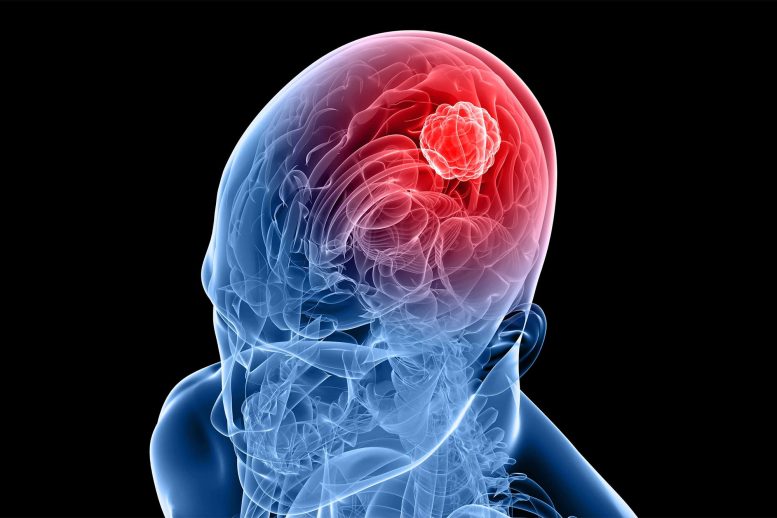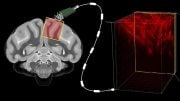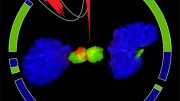
The first human trial of a novel ultrasound device demonstrated its potential to temporarily open the blood-brain barrier and deliver chemotherapy directly to the brain. This innovative procedure led to a significant increase of four to six times in drug concentrations in the brain, and patients were awake during the four-minute procedure which was repeated every few weeks for several months. Currently, there is no effective treatment for glioblastoma, making this new ultrasound technique a promising development in the fight against this devastating disease.
A novel ultrasound technique utilizing microbubbles temporarily opens the blood-brain barrier to treat glioblastoma in humans.
One of the biggest challenges in treating glioblastoma, a fatal brain cancer, is that the most effective chemotherapy drugs cannot penetrate the blood-brain barrier to reach the fast-growing brain tumor.
Northwestern Medicine researchers have recently reported the results of the first human clinical trial where they utilized a new, skull-implantable ultrasound device. This device opens the blood-brain barrier, allowing for repeated permeation of large areas of the brain, thus enabling the delivery of intravenously injected chemotherapy.
The four-minute procedure to open the blood-brain barrier is performed with the patient awake, and patients go home after a few hours. The results show the treatment is safe and well tolerated, with some patients getting up to six cycles of treatment.
This is the first study to successfully quantify the effect of ultrasound-based blood-brain barrier opening on the concentrations of chemotherapy in the human brain. Opening the blood-brain barrier led to an approximately four- to six-fold increase in drug concentrations in the human brain, the results showed.
Scientists observed this increase with two different powerful chemotherapy drugs, paclitaxel, and carboplatin. The drugs are not used to treat these patients because they do not cross the blood-brain barrier in normal circumstances.
This video demonstrates the dynamic opening of the BBB opening intra-operatively. Following brain sonication and administration of intravenous microbubbles, scientists injected fluorescein intravenously, as this dye does not normally penetrate into the brain. They first observed fluorescein in the arteries, then the whole brain was fluorescent, as this dye was in the capillaries, followed by the brain veins. Eventually, after a few minutes, they observed accumulation of this dye in the brain regions that were sonicated where the blood-brain barrier was opened. Credit: The Lancet Oncology
In addition, this is the first study to describe how quickly the blood-brain barrier closes after sonication. Most of the blood-brain barrier restoration happens in the first 30 to 60 minutes after sonication, the scientists discovered. The findings will allow optimization of the sequence of drug delivery and ultrasound activation to maximize the drug penetration into the human brain, the authors said.
“This is potentially a huge advance for glioblastoma patients,” said lead investigator Dr. Adam Sonabend, an associate professor of neurological surgery at Northwestern University Feinberg School of Medicine and a Northwestern Medicine neurosurgeon.
Temozolomide, the current chemotherapy used for glioblastoma, does cross the blood-brain barrier, but is a weak drug, Sonabend said.
The paper was recent published in the journal The Lancet Oncology.
The blood-brain barrier is a microscopic structure that shields the brain from the vast majority of circulating drugs. As a result, the repertoire of drugs that can be used to treat brain diseases is very limited. Patients with brain cancer cannot be treated with most drugs that are otherwise effective for cancer elsewhere in the body, as these do not cross the blood-brain barrier. Effective repurposing of drugs to treat brain pathology and cancer requires their delivery to the brain.
In the past, studies that injected paclitaxel directly into the brain of patients with these tumors observed promising signs of efficacy, but the direct injection was associated with toxicity such as brain irritation and meningitis, Sonabend said.
Blood-brain barrier recloses after an hour
The scientists discovered that the use of ultrasound and microbubble-based opening of the blood-brain barrier is transient, and most of the blood-brain barrier integrity is restored within one hour after this procedure in humans.
“There is a critical time window after sonification when the brain is permeable to drugs circulating in the bloodstream,” Sonabend said.
Previous human studies showed that the blood-brain barrier is completely restored 24 hours after brain sonication, and based on some animal studies, the field assumed that the blood-brain barrier is open for the first six hours or so. The Northwestern study shows that this time window might be shorter.
In another first, the study reports that using a novel skull-implantable grid of nine ultrasound emitters designed by French biotech company Carthera opens the blood-brain barrier in a volume of brain that is nine times larger than the initial device (a small single-ultrasound emitter implant). This is important because to be effective, this approach requires coverage of a large region of the brain adjacent to the cavity that remains in the brain after the removal of glioblastoma tumors.
Clinical trial for patients with recurrent glioblastoma
The findings of the study are the basis for an ongoing phase 2 clinical trial the scientists are conducting for patients with recurrent glioblastoma. The objective of the trial — in which participants receive a combination of paclitaxel and carboplatin delivered to their brain with the ultrasound technique — is to investigate whether this treatment prolongs the survival of these patients. A combination of these two drugs is used in other cancers, which is the basis for combining them in the phase 2 trial.
In the phase 1 clinical trial reported in this paper, patients underwent surgery for resection of their tumors and implantation of the ultrasound device. They started treatment within a few weeks after the implantation.
Scientists escalated the dose of paclitaxel delivered every three weeks with the accompanying ultrasound-based blood-brain barrier opening. In subsets of patients, studies were performed during surgery to investigate the effect of this ultrasound device on drug concentrations. The blood-brain barrier was visualized and mapped in the operating room using a fluorescent die called fluorescein and by MRI obtained after ultrasound therapy.
“While we have focused on brain cancer (for which there are approximately 30,000 gliomas in the U.S.), this opens the door to investigate novel drug-based treatments for millions of patients who suffer from various brain diseases,” Sonabend said.
Reference: “Repeated blood–brain barrier opening with an implantable ultrasound device for delivery of albumin-bound paclitaxel in patients with recurrent glioblastoma: a phase 1 trial” by Adam M Sonabend, Andrew Gould, Christina Amidei, Rachel Ward, Karyn A Schmidt, Daniel Y Zhang, Cristal Gomez, John F Bebawy, Benjamin P Liu, Guillaume Bouchoux, Carole Desseaux, Irene B Helenowski, Rimas V Lukas, Karan Dixit, Priya Kumthekar, Víctor A Arrieta, Maciej S Lesniak, Alexandre Carpentier, Hui Zhang, Miguel Muzzio and Roger Stupp, 2 May 2023, The Lancet Oncology.
DOI: 10.1016/S1470-2045(23)00112-2
The study was funded by the National Cancer Institute.








Great job thank you.